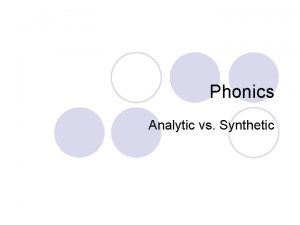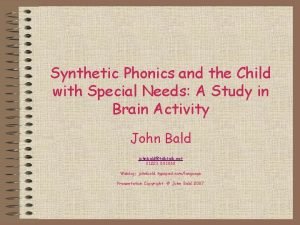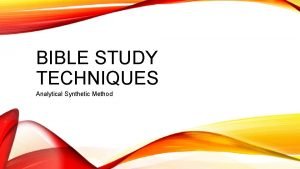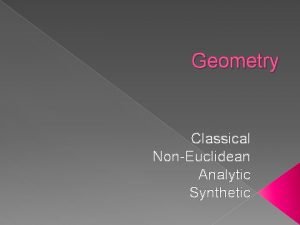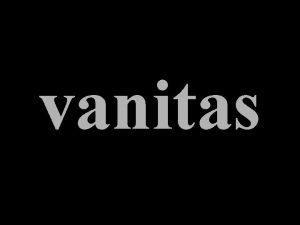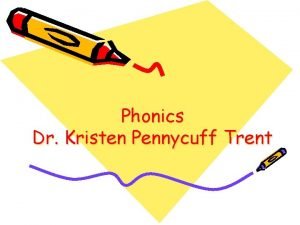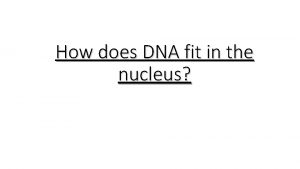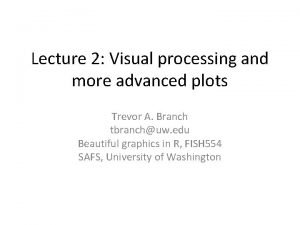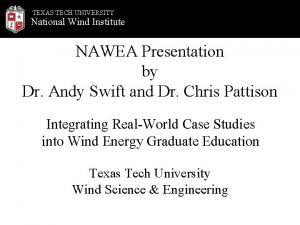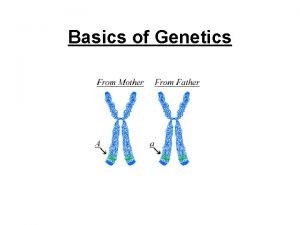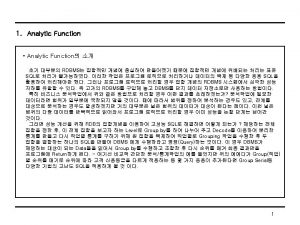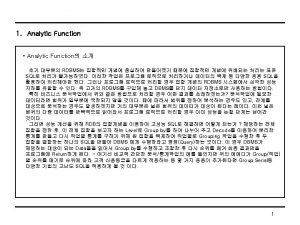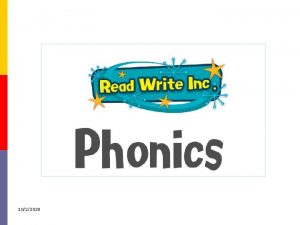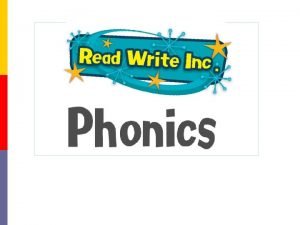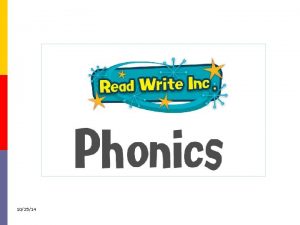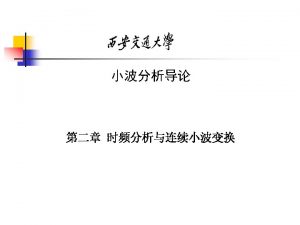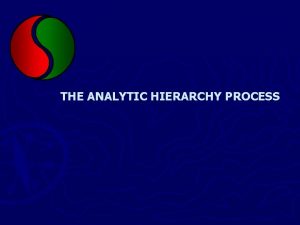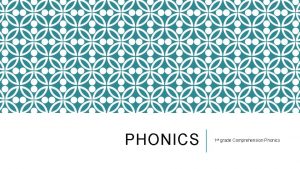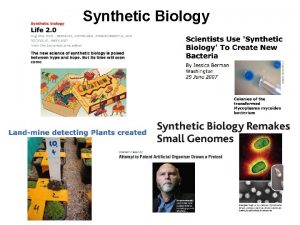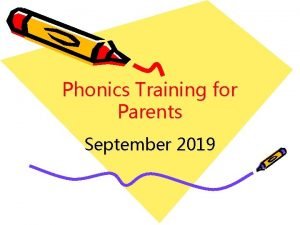Phonics Analytic vs Synthetic Phonics National Institute of













- Slides: 13

Phonics Analytic vs. Synthetic

Phonics (National Institute of Child Health & Human Development, 2000) l Phonics = the association between the letters in our alphabet and the sounds in our spoken language (i. e. phonemes) l Research shows that systematically teaching children to manipulate phonemes significantly improves children’s reading and spelling abilities ¡ Letter sounds are the “building blocks” of words l Research indicates that phonics instruction produces significant benefits for children K-6 th grade and for students having difficulties learning to read ¡ National Reading Panel recommended the teaching of systematic phonics for routine classroom instruction

Phonics (National Institute of Child Health & Human Development, 2000) l Phonics should be an essential component of a comprehensive reading program l Phonics should be embedded within meaningful texts and reading activities ¡Wray & Medwell (1999): Teachers who put the skills needed for decoding into context using meaningful texts for a real purpose were most effective l Two main approaches to teaching phonics: ¡Analytic phonics ¡Synthetic phonics

Analytic Phonics (Ruddell, 2002) l A. K. A. : Implicit phonics l This approach teaches letter-sound relationships in the context of the word in which it is found. l Compares unknown words to known words l Avoids pronouncing sounds in isolation ¡Ex: “b” says “bat” not “buh” l Children learn to identify words by their shape, their beginning and ending letters, and by the context which they are used in sentences, often with the aid of pictures.

How is Analytic Phonics Taught? (Watson & Johnston, 2000) l It starts at the whole word level l Instruction usually begins with teaching the child to read a set of pre-selected words by sight l Typically, students are taught one letter sound per week l Students are shown a series of alliterative pictures and words which start with that sound ¡Ex: car, cat, cake, castle

Teaching Analytic Phonics, Cont. (Watson & Johnston, 2000) l When the 26 initial letter sounds have been taught, students are introduced to middle sounds and final sounds. ¡ Ex: cat, bag, rag Ex: nap, cup, pip l Initial consonant blends ¡ Ex: ‘bl’, ‘cr’, ‘sp’ l Final consonant blends ¡ Ex: ‘nt’, ‘ng’, ‘st’ l Vowel and consonant digraphs ¡ Ex: ‘ee’, ‘oo’, ‘ch’, ‘sh’ l Silent “e” ¡ Ex: ‘slate’, ‘blue’

Teaching Analytic Phonics, cont. (www. dyslexics. org. uk) l When the child comes across an unfamiliar word, they are trained to break the word down into ‘onset’ and ‘rime’. ¡Onset: initial consonant or consonant cluster is sounded out ¡Rime: the rhyming family that the rest of the word belongs to is then sounded out l. Ex: The “ot” family: pot, rot, cot

Synthetic Phonics (www. synthetic-phonics. com) l A. K. A. : Explicit Phonics l Synthetic phonics teaches letter-sound relationships by articulating the sound in isolation ¡Contrasts analytic phonics, which teaches lettersound relationships in the context of whole words l Children learn to synthesize pronunciations for unfamiliar written words by translating letters into sounds and blending the sounds together l Generally taught when children are first introduced to reading

Teaching Synthetic Phonics (www. synthetic-phonics. com) l First Step: Teach the sounds individual letters make. 1. 2. We CAN show it in the context of known words. We DO focus on each letter individually and how it fits into the whole word l Teaching Example: Write the letter b on the board along with the words bat, book, and better. Say: “The sound of b is /buh/. Let’s say the sound together (as you point to the letter b), /buh/. This is the sound we hear at the beginning of the words bat, book, and better (as you underline the b in each word). Let’s say the sound together again, /buh/. ”

Teaching Synthetic Phonics (www. synthetic-phonics. com) l Second Step: Students learn how to blend the sounds together to form recognizable words ¡e. g. After students have learned the letters a, b, c, and t, they can be shown how to blend the letters together to form the words bat, cat, and cab l Third Step: Students are taught to sound out and blend letters to pronounce unfamiliar words l Rapid approach: ¡Students typically learn about 6 phonemes per week ¡Students learn most common letter-sound relationships in a matter of weeks

Analytic vs. Synthetic (Watson & Johnston, 2000) l Analytic: ¡ The whole word is seen and students have their attention drawn to certain letters and their sounds ¡ Taught after an initial sight vocabulary has been established ¡ Breaks down from whole to part l Synthetic: ¡ All of the letter sounds are taught very rapidly and the emphasis is on how words are built up ¡ Generally starts before students are introduced to whole words or reading scheme books ¡ Builds up from part to whole

Synthetic or Analytic? ? What type of phonics should we use?

References/Resources l Hiskes, D. (1998). Explicit or implicit phonics: “Therein lies the rub”. Right to Read Report(2). l National Institute of Child Health and Human Development, 2000. National Reading Panel Reports Combination of Teaching Phonics, Word Sounds, Giving Feedback on Oral Reading Most Effective Way to Teach Reading. Retrieved from: http: //www. nichd. nih. gov/new/releases/nrp. cfm l www. nationalreadingpanel. org l Ruddell, R. (2002). Teaching children to read and write: Becoming an effective literacy teacher, 3 rd ed. Allyn and Bacon: CA. l www. syntheticphonics. com l www. synthetic-phonics. com l The main method to teaching reading. (n. d. ). Retrieved December 5, 2005, from http: //www/aowm 73. dsl. pipex. com/dyslexics/main_method_2. htm l Watson, J. & Johnston, R. (1998). Accelerating reading attainment: The effectiveness of synthetic phonics. Retrieved from http: //www. scotland. gov. uk/edru/pdf/ers/interchange_57. pdf.
 Synthetic phonics vs analytic phonics
Synthetic phonics vs analytic phonics Synthetic vs analytic phonics
Synthetic vs analytic phonics Synthetic bible study method
Synthetic bible study method Analytical and euclidean geometry
Analytical and euclidean geometry Picasso bowl
Picasso bowl Analytic phonics
Analytic phonics National human genome research institute
National human genome research institute National human genome research institute
National human genome research institute Mozambique national institute of meteorology
Mozambique national institute of meteorology Xkcd 1080
Xkcd 1080 National institute of electronics
National institute of electronics National wind institute
National wind institute Kharkiv national technical university
Kharkiv national technical university Translation
Translation
